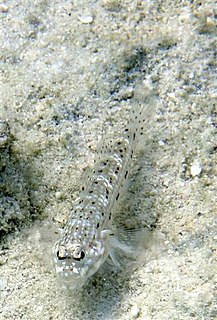Collared wrigglers are perciform fishes in the family Xenisthmidae. They are native to the Indian and Pacific Oceans, where they are mostly reef-dwelling.

Fusigobius is a genus of coral reef inhabiting gobies found throughout the Indian and western Pacific Oceans.

Plectranthias is a genus of fish in the family Serranidae found in the Atlantic, Indian and Pacific Ocean.
Pascua is a genus of gobies native to the Pacific Ocean. The origin of the name "Pascua" is from the Spanish for "Easter" in recognition of the Easter Island range of the type specimen.

Valenciennea is a genus of small, bottom-dwelling fish in the family Gobiidae. They are found over sandy bottoms, often at coral reefs in the Indo-Pacific. The members of the genus tend to rest directly on the substrate for extended periods of time. While this is a common behavior for members of the family, this genus also float motionless directly above the substrate, which is why they are sometimes called glider gobies. Their resting behavior has resulted in the vernacular name "sleeper gobies", which invites confusion with the related family Eleotridae. The members of this genus are known to be carnivorous sand-sifters; to eat, they simply engulf entire mouthfuls of sand which they expel through their gills. Specialized structures in their gills filter small crustaceans and worms as the sand is expelled. It is this specific trait that makes some members of the genus attractive to the marine aquarist, and they are often introduced into a marine aquarium for sand-sifting. Some of the species are known to be monogamous. The genus was named after notable French zoologist Achille Valenciennes. These fish are difficult to keep in a tank. Tanks with plenty of live sand and live rock are recommended. Offer foods such as sinking shrimp pellets. Fish may die even if eating properly.

Amblyeleotris is a genus of fish in the family Gobiidae found throughout the Indo-Pacific region. This is the largest genus of the shrimp gobies or prawn gobies, so-called because of their symbiotic relationship with certain alpheid shrimps. The shrimp excavates and maintains a burrow used by both animals while the goby, which has far superior eyesight, acts as a lookout for predators. The shrimp maintains almost constant contact with the fish with an antenna.These species vary considerably in size from less than 30 mm to almost 200 mm standard length.

Hypseleotris is a genus of fishes in the family Eleotridae. Most are from fresh water in Australia and New Guinea, but species in fresh and brackish water are found around islands in the western Indian Ocean, southern and eastern Africa, southern and eastern Asia, and Pacific islands. The largest species reaches a length of 12 cm (4.7 in). They are sometimes seen in the aquarium trade; especially H. compressa. In Australia they are known as carp gudgeons.

Priolepis is a genus of fish in the family Gobiidae with a cosmopolitan distribution.

Tomiyamichthys is a genus of gobies found from the Red Sea through the Indian Ocean to the western Pacific Ocean. The name of this genus honours the Japanese ichthyologist Itiro Tomiyama of the Tokyo Imperial University, who described the type species, Tomiyamichthys oni, in 1936.

Xenisthmus is the most well-known genus in the family Xenisthmidae,which is regarded as a synonymous with the Eleotridae, a part of Gobiiformes. These small to very small fish are known as wrigglers, and live in reefs and among rubble in the Indo-Pacific.

Kuhlia mugil, the barred flagtail or the five-bar flagtail, is a species of flagtail belonging to the family Kuhliidae.

Cryptocentrus also known as Watchman gobies, and one of the genera known as shrimp gobies or prawn gobies, is a genus of gobies native to tropical marine waters of the Indian and Pacific oceans.
Barbulifer is a genus of gobies native to the tropical Atlantic coast of the Americas as well as the Gulf of California on the Pacific coast.
Egglestonichthys is a genus of gobies native to brackish and marine waters of the Indian Ocean and the western Pacific Ocean.
Gnatholepis is a genus of fish in the family Gobiidae, the gobies. It is the only marine genus in the subfamily Gobionellinae, which otherwise includes mostly estuary-dwelling and freshwater fish. Gnatholepis are tropical fish associated with sandy habitat around corals.

Nesogobius is a genus of goby native to the coastal waters of Australia.

Stonogobiops is a genus of gobies native to the Indian and Pacific oceans. This is one of the "shrimp goby" genera, the members of these genera being commensal with various species of shrimps.
Sueviota is a genus of fish in the family Gobiidae native to the Indian and Pacific Ocean.

Ptereleotris is a genus of dartfishes found in the Atlantic, Indian and Pacific oceans.















